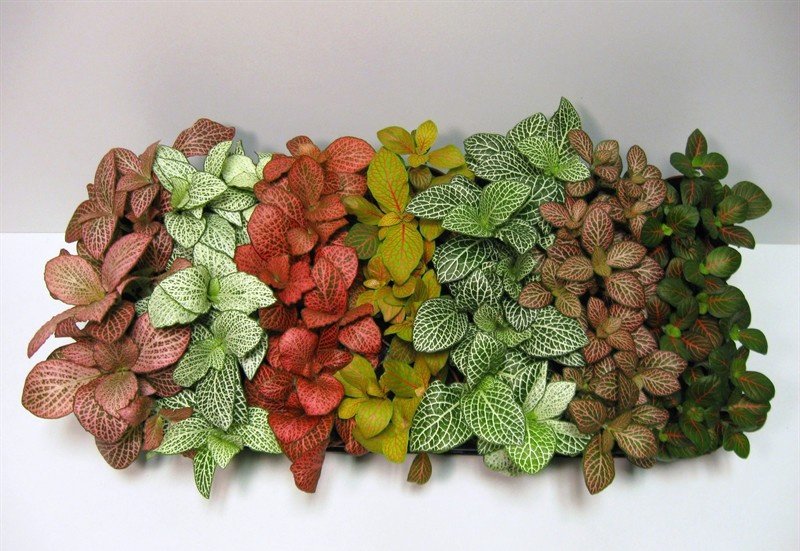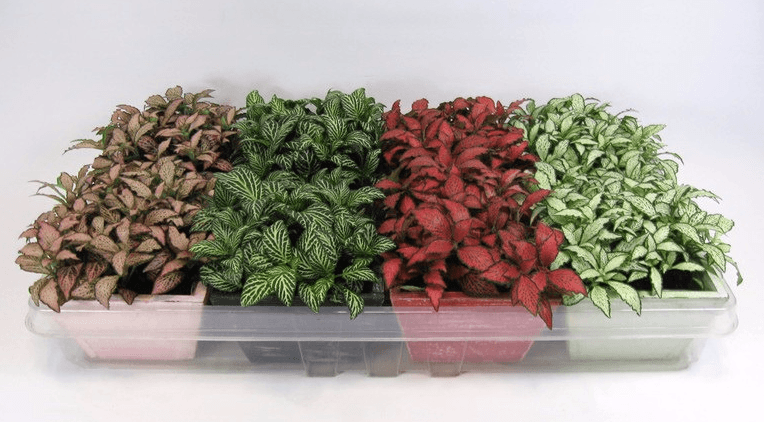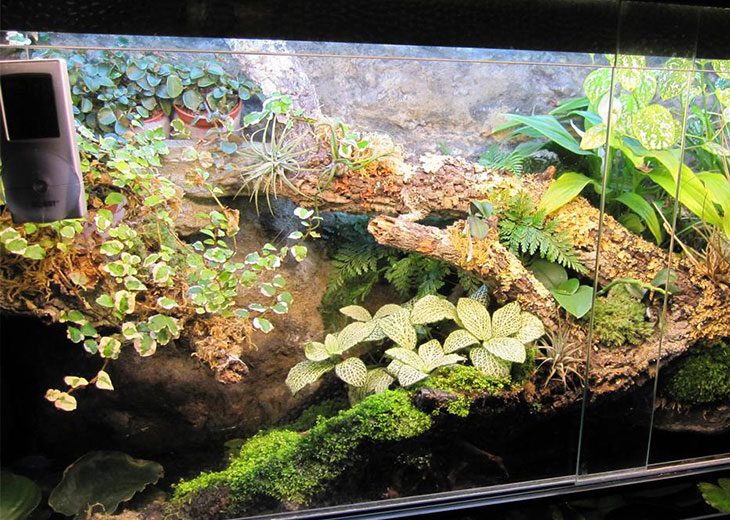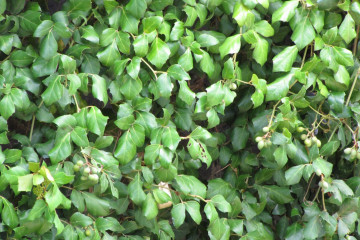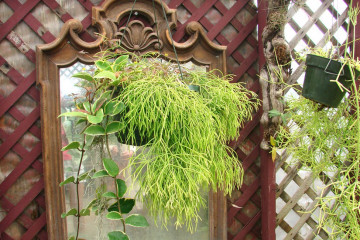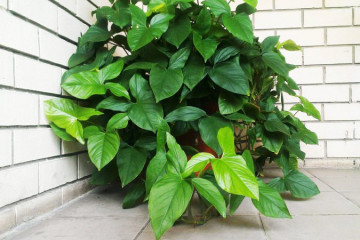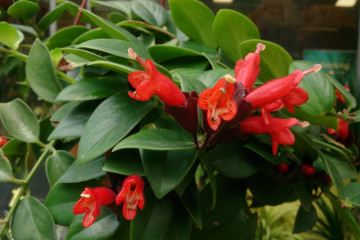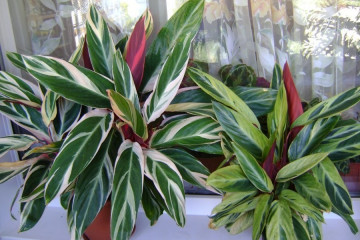Fittonia - home care and reproduction
Content:
The elegance and elegance of the indoor plant Fittonia amazes even the most sophisticated flower growers. It will take a lot of effort to grow a gorgeous flower at home. Exotic plant Fittonia, home care for which has its own characteristics, is able to decorate any interior of the house. In the article you can familiarize yourself with the peculiarities of the content of decorative culture.
Description
Fittonia belongs to the plants of the Acanthus family. The native land of the herbaceous perennial is Peru. The height of a houseplant can reach 10-60 cm. Depending on the variety, perennial stems can be:
- upright;
- creeping along the surface of the ground.
Fittonia is successfully grown as an ampel or ground cover plant. The length of the stems reaches 8-10 cm. The pubescent stems can be colored both green and brown. The ovoid foliage with a pointed tip densely covers the entire length of the shoots. The length of the leaves can reach 10 cm. The green mass is distinguished by a relief-corrugated surface, velvety, delicate and very pleasant to the touch. On the leaf plates, the thinnest cobweb, painted in:
- white;
- pink;
- red;
- lilac;
- silvery tones.
Leaves, depending on the variety, can be purple, gray-silver and bluish.
Types and varieties of fittonia
Below are the most popular types of Fittonia.
- Fittonia Mix is a representative of a perennial herb, distinguished by branched and densely pubescent stems, the height of which reaches 8-10 cm. The perennial has a superficial root system. Its shoots densely cover the surface of the soil. Roots are able to form even in the nodal parts. Oval-elliptical foliage forms on petioles. The length of the sheet plates reaches 70-90 mm. Matte green foliage has bright streaks in various shades. Home care for Fittonia Mix is not particularly difficult;
- Fittonia Josan is a perennial herbaceous crop. On the bright leaves of an emerald hue, the presence of thick veins of a bright pink palette is noted;
- red fittonia - a representative of the Acanthus family, which is distinguished by dark emerald foliage with the presence of red veins;
- Fittonia Skeleton is an amazing variety, which is distinguished by its peculiar color and foliage structure. Shoots at Fittonia Skelleton are creeping. The fine velvety matte foliage is decorated with reddish veins that resemble a dense net. Leaf plates in olive shades. The intensity of the color spectrum makes it possible to achieve a glowing effect;
- Fittonia White Anna is a perennial with patterns on the white foliage. There is a dark border on the extreme part of the leaf plates. The white-streaked variety is distinguished by its unpretentiousness;
- Fittonia Vershaffelt is a culture characterized by creeping shoots densely covered with fluff.The variety can be easily propagated by layering. The green foliage has red streaks;
- White Fittonia is a type of Fittonia that is similar to White Anna. There is no border along the edges of the sheet plates. The veins of a snow-white shade are quite dense.
Care features
Proper care of a herbaceous perennial will allow you to grow a healthy plant that will delight you with a chic appearance.
Illumination
Often, inexperienced growers wonder how to care for Fittonia. To grow a perennial at home, you need to take care of a sufficient amount of lighting in the room where the pots are located. However, you should avoid direct sunlight on the green mass. Experienced florists recommend growing Fittonia on windowsills on the east or west side. Blinds should be hung on the windows to provide diffused light to the flowers.
Temperature regime
In the warm season, the temperature in the room in which the flower pots are kept should be in the range of 23-25 ° C. In the winter months, the temperature regime can be slightly reduced, but not fall below 19 ° C. Cool air provokes the development of various diseases, which can lead to the death of bushes. In order to avoid foliage falling, it is recommended to avoid drafts in the room and sudden changes in air temperature. Even in the summer, you should not take the pots with perennials outside the apartment.
Watering
A representative of the Acanthus family needs systematic soil moistening. When the soil dries out, the plant begins to shed its foliage intensively. However, do not flood the flowers, as the swampy ground will cause root decay. Moistening is performed only during periods of drying of the topsoil. For irrigation, use settled water at room temperature.
Spraying
In addition to watering, Fittonia needs systematic spraying. If you ignore this recommendation, the moisture level will decrease, which will cause pests to appear on the plant.
It is advisable to spray every day before sunrise and after sunset. Experienced growers recommend placing vessels filled with water near the pots with plants, which will increase the level of humidity.
Fertilizer
Throughout the year, it is necessary to make top dressing. The amount of fertilizer should not exceed the dosage recommended by the manufacturer. Excessive amounts of micronutrients in the soil can cause irreparable damage to the bushes. Complex mineral fertilizers will be an ideal option for feeding Fittonia.
In winter, fertilizing is applied once every 5-6 weeks. In the summer months, the frequency of feeding reaches 1 time in 14 days.
Pruning
In order to improve the branching of plants, it is recommended to regularly pinch the upper parts of the stems. As it grows, the lower part of the decorative culture begins to bare.
Fittonia is a flower that gradually loses its decorative qualities. To rejuvenate the bushes, it is necessary to prune it at the end of the last week of March. It is necessary to carry out activities in two stages so as not to harm the green space and not to slow down the rate of development of young shoots.
Features of winter care
Fittonia care is not easy. The flower is difficult to survive the winter, because at this time of the year the heating is turned on in the rooms, which greatly dries the air. But even the coolness can negatively affect the health of the plant and even lead to its death.The room temperature should not drop below 17 ° C according to the rules of care, and the pots should be placed away from the batteries. Vessels filled with water can be placed near containers with flowers.
How to propagate
The plant can be propagated during the transplant period, allowing the shrubs to rejuvenate.
Suitable cuttings with 3-5 leaves are cut from the top of the bush. To speed up the rooting process, it is worth choosing shoots, the length of which reaches 60-70 mm. Cuttings are planted in the sand with the cut tip down. From above, the processes are covered with glass jars. After four weeks, roots should appear on the cuttings. It is important to moisten the sand in a timely manner and remove the cans for airing.
For the purpose of rooting, you can use a container with water, which should only slightly cover the surface of the bottom of the container. The cuttings located in the container are covered from above with a film material, which must be removed every three days for airing. The cuttings are systematically moistened by spraying. To speed up the rooting process, the temperature in the room where the containers with water are located should be kept within 28-29 ° C. As soon as roots form on the processes, you can plant the cuttings in a container filled with fertile soil. Reproduction of Fittonia is not a difficult process.
How to transplant
With age, Fittonia loses its decorative effect, therefore experienced flower growers recommend replanting the plant in order to rejuvenate the bush. The first step is to pick up a wide and low pot, on the bottom surface of which a layer of expanded clay is placed. On top of this, a soil layer is poured based on:
- peat;
- sand;
- turf land;
- coniferous soil.
The plant is carefully planted in a new container. A soil mixture is poured over the root system.
Fittonia belongs to the category of tropical plants that need careful care. However, all the efforts of the grower are compensated by the attractive appearance of an exotic flower, which will delight every day and give a lot of pleasant emotions from the abundant flowering.
